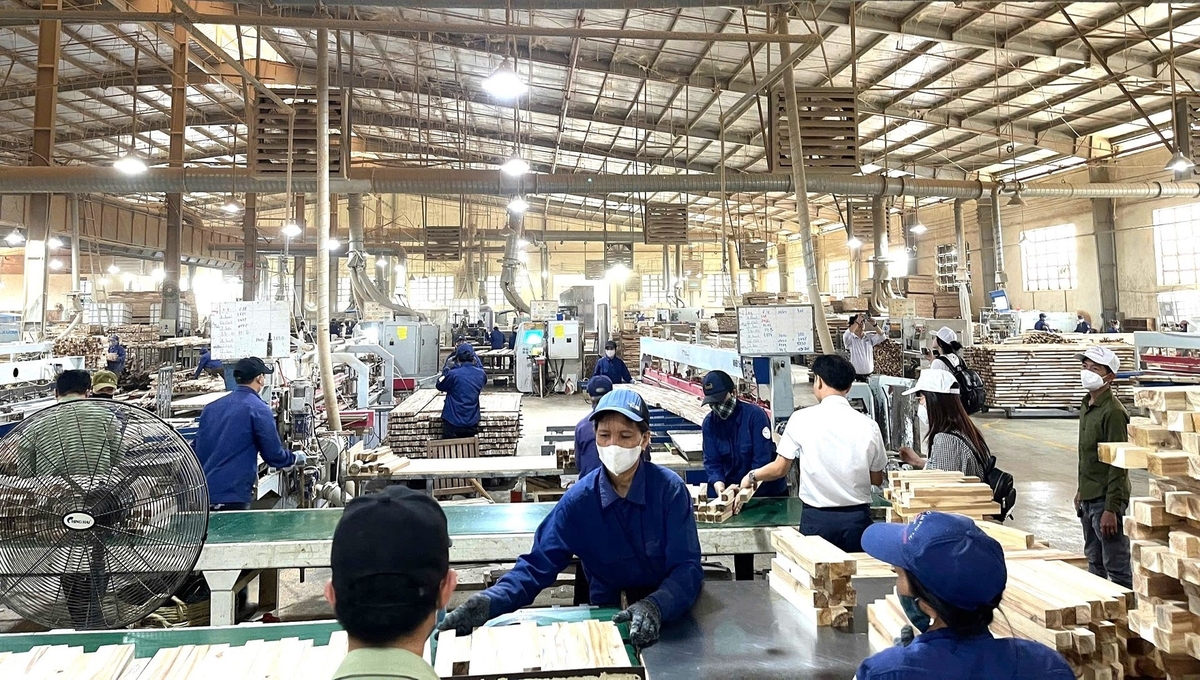May 29, 2025 | 09:29 GMT +7
May 29, 2025 | 09:29 GMT +7
Hotline: 0913.378.918
May 29, 2025 | 09:29 GMT +7
Hotline: 0913.378.918
According to Mr. Nguyen Tuan Hung, a representative of the Department of Forestry and Forest Protection (Ministry of Agriculture and Environment), the goal outlined in the Prime Minister’s Decision 327 is for Vietnam’s wood industry to reach an export turnover of USD 20 billion by 2025 and increase to USD 25 billion by 2030.
However, Mr. Hung also emphasized that this presents a significant challenge for Vietnam’s wood industry. In the coming years, the sector will face numerous difficulties as the EU’s Deforestation Regulation (EUDR) takes effect and global geopolitical conflicts continue to impact export markets.
Mr. Le Van Luong, General Director of Dai Thanh Wood Technology Joint Stock Company (Quy Nhon City, Binh Dinh), shared his concerns, stating that just as the wood industry was beginning to show signs of recovery in 2024, new U.S. tariffs imposed on one of Vietnam’s four largest export markets are now posing major threats to the sector’s exports.

Mr. Nguyen Tuan Hung, representative of the Department of Forestry and Forest Protection, discusses the challenges facing Vietnam's wood industry in the coming period. Photo: V.D.T.
"Recently, the import of commercial wood into the U.S. market has experienced fluctuations, leaving businesses, especially those producing interior furniture, in a state of uncertainty. Kitchen cabinets and bathroom cabinets, in particular, face high risks, with kitchen cabinets specifically at risk of being subjected to U.S. tariffs," expressed Mr. Le Van Luong with concern.
According to Mr. Luong, kitchen cabinets hold great potential in achieving Binh Dinh’s wood industry’s export revenue target of USD 2 billion in the coming years. However, given the current market volatility, this poses a significant challenge for businesses. "If the U.S. imposes tariffs on imported wooden products, it will greatly impact the export revenue targets of the wood industry. Despite these concerns, wood enterprises in Binh Dinh cannot afford to halt investments and must find every possible way to survive," Mr. Le Van Luong affirmed.

Mr. Le Van Luong, General Director of Dai Thanh Wood Technology Joint Stock Company (Quy Nhon City, Binh Dinh), expresses concern that U.S. tariffs will significantly impact Vietnam's wood exports. Photo: V.D.T.
Aside from the U.S., which is a major market for indoor wooden furniture, Europe is also a significant market, particularly for outdoor wooden products. These present major challenges for wood enterprises in Binh Dinh province.
"In light of this reality, wood businesses in Binh Dinh hope that the Binh Dinh Wood and Forest Products Association will closely coordinate with the Vietnam Timber and Forest Products Association and the Ministry of Agriculture and Environment to monitor market trends and promptly provide information. This will help businesses prepare in advance and respond effectively to sudden market fluctuations," Mr. Le Van Luong suggested.
Mr. Vo Quang Ha, Chairman of Tan Vinh Cuu Joint Stock Company (Tavico) in Dong Nai, shared: "For Vietnam's wood industry to develop amid the current challenges, businesses must first reposition their market strategy - determine which products are sold to which markets, where those products should be manufactured, and where to source raw materials. If using domestically grown forests, it is essential to identify the most suitable tree species for cultivation."
Based on this, authorities should analyze the competitive advantages of each locality, determine which types of timber are suitable for specific products, and assess whether the wood industry can be self-sufficient or needs to rely on imports, thus forming distinct product groups. Currently, the industry must adopt a new mindset to navigate immediate difficulties. Additionally, the wood sector should not overly depend on exports but also pay attention to the domestic market.

Mr. Vo Quang Ha, Chairman of Tan Vinh Cuu Joint Stock Company (Dong Nai), proposes solutions for the sustainable development of the wood industry. Photo: V.D.T.
"In the face of numerous challenges in the export market, the wood industry needs to categorize its markets more specifically. For example, the U.S., as a major market, should be grouped separately, China as another, the European market as one, the North Asian market (including South Korea and Japan) as another, and the rest of the world in one group, along with the domestic market," Mr. Ha suggested.
According to Mr. Ha, by dividing the market into these groups, the wood industry can determine which products are suitable for which markets. From there, it can identify which localities have strengths in specific products and focus production accordingly. This strategic focus will help establish supply chains and secure raw material sources.
"The EU market is particularly concerned about EUDR. We need to identify which products are in high demand in this region and ensure compliance with EUDR for those products, making it easier for them to enter the European market," Mr. Vo Quang Ha proposed.

For Vietnam's wood industry to grow amid the current challenges, businesses must first reposition their market strategy. Photo: V.D.T.
According to Mr. Pham Anh Tuan, Chairman of the Binh Dinh Provincial People's Committee, growing large timber forests to supply raw materials for the wood industry is an inevitable trend for Vietnam to address the challenges of traceability requirements under the EUDR.
Mr. Pham Anh Tuan, Chairman of the Binh Dinh Provincial People's Committee, stated: "Developed countries like Japan grow forests for up to 50 years, while European countries cultivate large timber forests for 20 years. In contrast, Vietnam has only reached a 10-year cycle. The government needs policies to support farmers in growing large timber forests to establish high-quality raw material areas."
Translated by Kieu Chi
/2025/05/25/4127-3-073637_820.jpg)
(VAN) Thanks to the promotion from an FAO-implemented project, vegetable production in greenhouses in Moc Chau has seen strong development, from 1.5 hectares in 2021 to nearly 50 hectares in 2024.

(VAN) FAO has recently supported USD 140,000 to implement the project 'Risk mitigation human-animal interface risks through disease control initiatives in pig farming.'

(VAN) The People's Committee of Tra Vinh province has approved an adjustment to the investment policy for the Green Hydrogen Plant project, increasing its area to approximately 52.76 hectares.
![Reducing emissions from rice fields: [2] Farmers’ commitment to the soil](https://t.ex-cdn.com/nongnghiepmoitruong.vn/608w/files/news/2025/05/05/dsc08881jpg-nongnghiep-140632.jpg)
(VAN) Clean rice cultivation model in Thuong Tan commune, Bac Tan Uyen district, is assisting local residents in achieving sustainable agriculture by substantially reducing costs, increasing productivity, and protecting the environment.

(VAN) At the conference to disseminate Resolution No. 68, AgriS introduced its digital agricultural ecosystem and reaffirmed its commitment to accompanying the Government in promoting private sector development and sustainable agriculture.

(VAN) 'Blue Ocean - Blue Foods' initiative is designed to restore marine ecosystems and establish sustainable livelihoods for local communities by cultivating a minimum of 1,000 hectares of cottonii seaweed in the first three years.
/2025/05/21/4642-3-112707_603.jpg)
(VAN) The V-SCOPE project has made direct contributions to three out of six pillars of the Comprehensive Strategic Partnership between Vietnam and Australia.